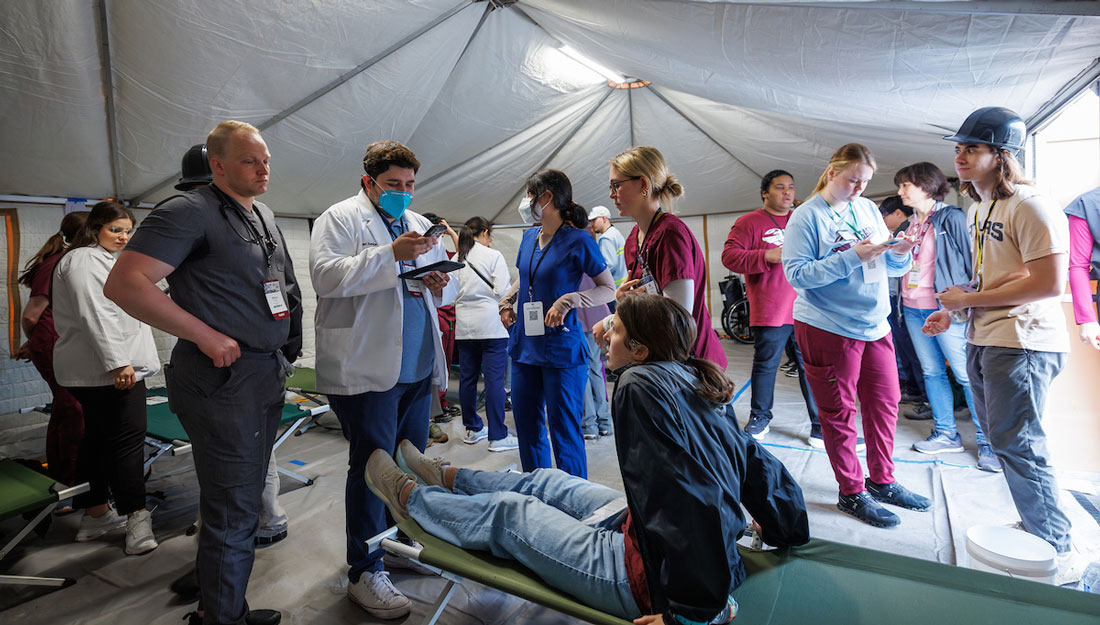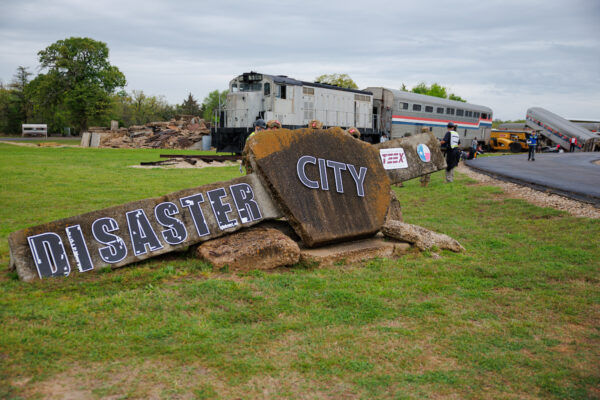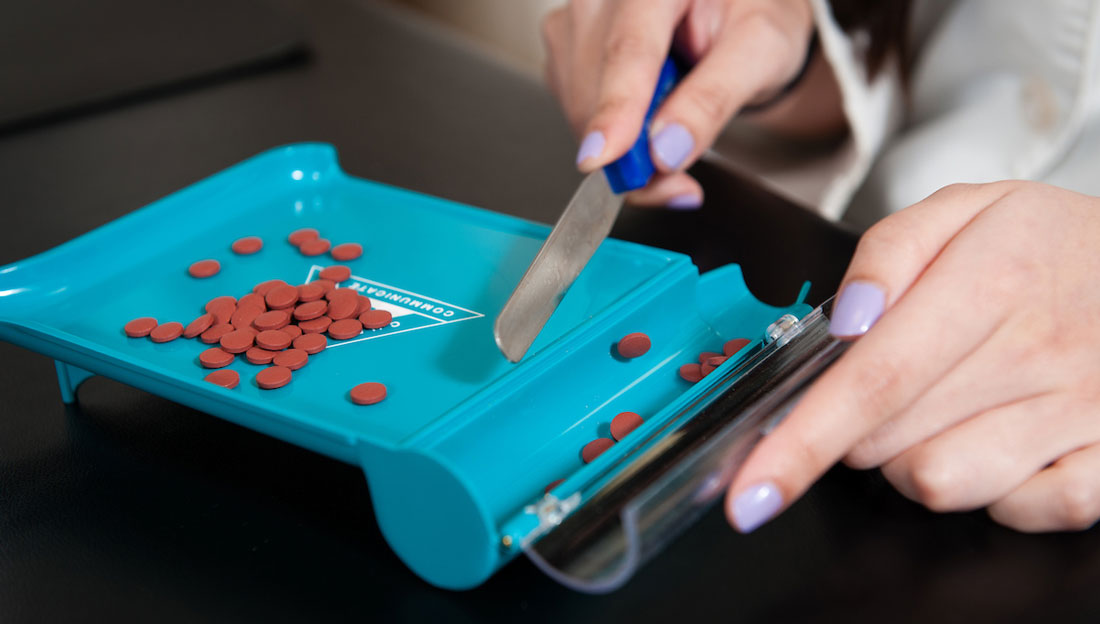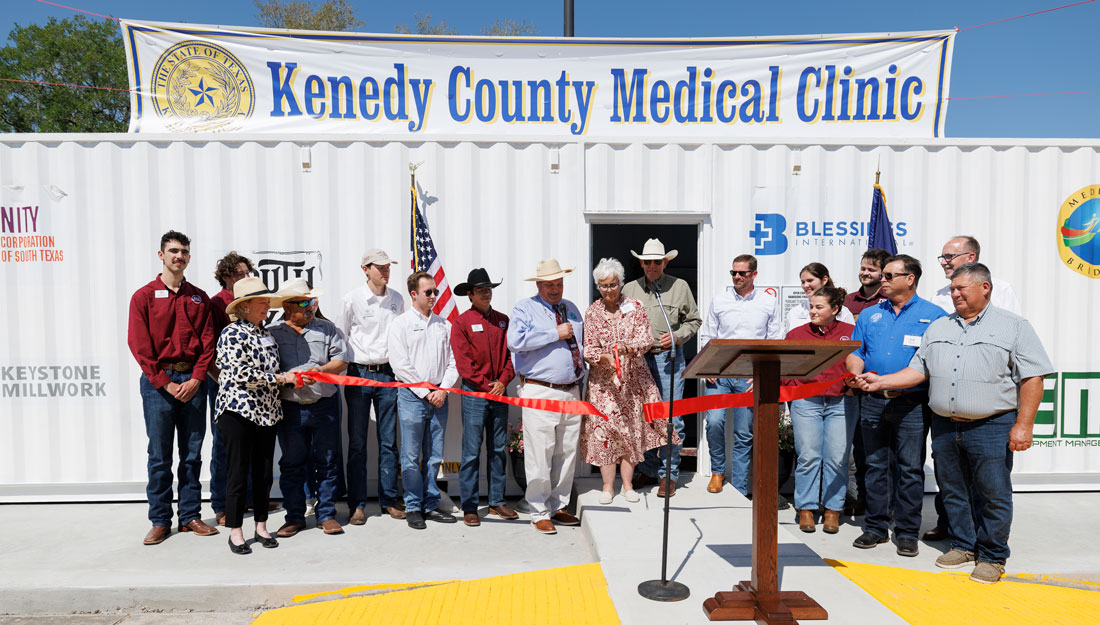- Laura Tolentino
- Community, Dentistry, Medicine, Nursing, Pharmacy, Public Health, Show on VR homepage
Disaster Day participants brave inclement weather to execute disaster-response simulation
Texas A&M Health joined with state and local partners to support the student-led event

Students in dentistry, medicine, nursing, pharmacy, public health, athletic training and psychology worked interprofessionally to respond in the simulated disaster. (Mathew Baughman / Texas A&M Health Marketing and Communications)
More than 600 Texas A&M University students braved forecasted rain alongside Texas A&M Health Science Center (Texas A&M Health) faculty and staff to conduct the 17th annual Disaster Day on March 28. As the nation’s largest student-led, interprofessional emergency response simulation, Disaster Day provides students with critical life-saving skills required in disaster situations.
This year’s exercise saw students navigating a simulated train derailment with complications arising from a hazardous materials spill at Texas A&M Engineering Extension Service‘s (TEEX) Disaster City, a 52-acre mock city that simulates real disasters and serves as a training facility for emergency responders. Event participants engaged in triage at the disaster site, patient care at mock field hospitals, mental health care and needs assessment at an evacuation shelter, and disaster management and simulation oversight.
Lessons in leadership and collaboration
Disaster Day affords student participants the opportunity to develop vital skillsets with the potential to substantially impact Texas communities, said Christine Kaunas, EdD, MPH, assistant vice president for Interprofessional Practice, Education and Research, the Texas A&M Health office that oversees the coordination of the event in concert with a student planning committee. In addition to disaster-response skills and disciplinary skills within individual fields like medicine, pharmacy or public health, students also learn team-based skills by practicing alongside other professions.
“Research shows that well-developed collaborative skills improve patient and population outcomes, especially during a disaster,” Kaunas said. “From 1980-2024, there were 190 confirmed weather/climate disaster events—an average of four per year—with losses exceeding $1 billion each, including wildfires, tropical storms, hurricanes and winter storms. Disaster Day equips our students to stand on the front lines, ready to serve when disaster strikes.”
In 2024, Americans grappled with record heat, wildfires and hurricanes. April alone brought more than 100 active tornadoes amidst still-wintry weather in parts of the United States.

Real world need is exactly the appeal of Disaster Day for first-year medical student Cynthia Emeremnu ’28, who participated as a patient simulating burn wounds during today’s event.
“It’s real life,” Emeremnu said. “One day there’s a hurricane or an earthquake or a shooting. We should be prepared as providers to be able to assist in these situations. This is what we train our whole lives to do.”
On the other side of the simulation, Marion Posner ’28, also a first-year medical student, participated as a provider. She said her experience provided realistic practice for responding in a high-stress environment.
“Even though it was a practice scenario, you do get immersed,” she said. “The adrenaline was flowing and the nerves were there, but if you just take a second to breathe and remember that you’re there to help them, that puts it all into perspective.”
Posner said she appreciates the wide range of departments and specialties Disaster Day unites in the service of disaster preparedness. Despite such varied backgrounds, responders practice working together to get patients the emergency care they need.
“It doesn’t really matter what your focus is, because there are a lot of key players on the team,” Posner said. “All of us came together, and it was really cool to see everyone here.”
Student initiative and planning
For Student Planning Director Tyler Watson ‘27, the annual exercise embodies the best of Texas A&M University.
“Being able to achieve this big feat to serve our fellow students, seeing so many people being excited is encouraging, because this matters to people,” Watson said. “It’s not an easy task, but it’s one that means a lot and will make a difference.”

This year was Watson’s third year to participate in Disaster Day. Starting off as a volunteer in the fall of 2022 on the student planning committee, he took on the role of incident commander for Disaster Day 2024. While serving as the student planning director for Disaster Day 2025, Watson is pursuing a doctorate in counseling psychology in the Texas A&M Department of Educational Psychology.
“Getting to see it from a different view has been really eye-opening,” Watson said. “As much as the disaster changes, the process doesn’t. In a disaster, you’re going to have chaos, you’re going to consistently need multiple disciplines to reach a common goal. No one discipline or person can solve it all, but the whole is consistently greater than the sum of the parts.”
This opportunity for growth sets apart Disaster Day for students looking to hone real-world skills, according to Kaunas.
“It’s truly a privilege to work with the next generation of health professionals as they take on the challenge of planning and implementing a large-scale and incredibly complex disaster response simulation,” Kaunas said. “Their dedication, ingenuity and collaborative spirit are nothing short of inspiring. They demonstrate an impressive ability to think critically, work across disciplines, and demonstrate exceptional talent and leadership potential that will shape the future of health care across our state.”
Continued commitment to preparedness
Disaster Day began in 2008 with a group of 35 students from the Texas A&M College of Nursing who, after watching Texas A&M provide disaster relief to the more than 650 individuals displaced to College Station by Hurricane Rita, conducted their own, day-long mock disaster. Today, a group of more than 50 students meets for six to eight months, under the guidance of Texas A&M faculty and staff and TEEX disaster response experts, to plan the annual, one-day event. Planning and event participants hail from across Texas A&M, including all five Texas A&M Health colleges and schools, the Texas A&M College of Education & Human Development, the Texas A&M College of Veterinary Medicine and Biomedical Sciences, and the Texas A&M Corps of Cadets. Event partners include multiple state and local government entities and non-governmental organizations (NGOs).
Over the years, Kaunas has watched Disaster Day evolve and pivot to reflect not only the natural disasters facing today’s medical professionals and emergency responders, but also the various logistical challenges presented over the years. During the COVID-19 pandemic, Disaster Day adopted a fully virtual format, as students persevered to facilitate the event despite stay-at-home orders.
“Planning a realistic disaster simulation of this scale is monumental,” Kaunas said. “The student planning committee and their faculty and staff steering committee have dedicated thousands of hours to make this event realistic and impactful for the student participants. The event also represents a model of multi-level cooperation across dozens of state and local entities, as well as NGOs and industry partners, which showcases the resources Texas A&M Health brings to bear for the most impactful student learning experience.”
As Disaster Day looks toward its 18th year, Kaunas anticipates the event will continue to grow as it reflects evolving challenges and new potential disaster scenarios.
“At Texas A&M Health, we take disaster response seriously,” Kaunas said. “We work to ensure our health professions students can adapt to address the many challenges of emergency situations and are prepared to respond when—not if—the next disaster strikes.”
Media contact: media@tamu.edu


